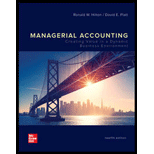
Laredo Leather Company manufactures high-quality leather goods. The company’s profits have declined during the past nine months. In an attempt to isolate the causes of poor profit performance, management is investigating the manufacturing operations of each of its products.
One of the company’s main products is leather belts. The belts are produced in a single, continuous process in the Dallas Plant. During the process, leather strips are sewn, punched, and dyed. The belts then enter a final finishing stage to conclude the process. Labor and
The leather belts produced at the Dallas Plant are sold wholesale for $9.95 each. Management wants to compare the current
The work-in-process inventory consisted of 400 partially completed units on October 1. The belts were 25 percent complete as to conversion. The costs included in the inventory on October 1 were as follows:

During October 7,600 leather strips were placed into production. A total of 7,000 leather belts were completed. The work-in-process inventory on October 31 consisted of 1,000 belts, which were 50 percent complete as to conversion.
The costs charged to production during October were as follows:

Required:
In order to provide cost data regarding the manufacture of leather belts in the Dallas Plant to the top management of Laredo Leather Company, compute the following amounts for the month of October.
- 1. The equivalent units for material and conversion.
- 2. The cost per equivalent unit of material and conversion.
- 3. The assignment of production costs to the October 31 work-in-process inventory and to goods transferred out.
- 4. The weighted-average unit cost of leather belts completed and transferred to finished goods. Comment on the company’s cost per belt used for planning and control.
- 5. Laredo Leather Company’s production manager, Jack Murray, has been under pressure from the company president to reduce the cost of conversion. In spite of several attempts to reduce conversion costs, they have remained more or less constant. Now Murray is faced with an upcoming meeting with the company president, at which he will have to explain why he has failed to reduce conversion costs. Murray has approached his friend, Jeff Daley, who is the corporate controller, with the following request: “Jeff, I’m under pressure to reduce costs in the production process. There is no way to reduce material cost, so I’ve got to get the conversion costs down. If I can show just a little progress in next week’s meeting with the president, then I can buy a little time to try some other cost-cutting measures I’ve been considering. I want you to do me a favor. If we raise the estimate of the percentage of completion of October’s inventory to 60 percent, that will increase the number of equivalent units. Then the unit conversion cost will be a little lower.” By how much would Murray’s suggested manipulation lower the unit conversion cost? What should Daley do? Discuss this situation, citing specific ethical standards for managerial accountants.
Want to see the full answer?
Check out a sample textbook solution
Chapter 4 Solutions
Managerial Accounting: Creating Value in a Dynamic Business Environment
- Need answerarrow_forwardFinancial Accounting Questionarrow_forwardOn July 31, Harrison Company had an Accounts Receivable balance of $25,400. During the month of August, total credits to Accounts Receivable were $68,000 from customer payments. The August 31 Accounts Receivable balance was $18,500. What was the amount of credit sales during August? A) $68,000 B) $39,100 C) $61,100 D) $75,900 E) $7,900 helparrow_forward
- On July 31, Harrison Company had an Accounts Receivable balance of $25,400. During the month of August, total credits to Accounts Receivable were $68,000 from customer payments. The August 31 Accounts Receivable balance was $18,500. What was the amount of credit sales during August? A) $68,000 B) $39,100 C) $61,100 D) $75,900 E) $7,900arrow_forwardAccountingarrow_forwardA company can sell all the units it can produce of either Product X or Product Y but not both. Product X has a unit contribution margin of $18 and takes four machine hours to make, while Product Y has a unit contribution margin of $25 and takes five machine hours to make. If there are 6,000 machine hours available to manufacture a product, income will be: A. $6,000 more if Product X is made B. $6,000 less if Product Y is made C. $6,000 less if Product X is made D. the same if either product is made. Helparrow_forward
 Managerial AccountingAccountingISBN:9781337912020Author:Carl Warren, Ph.d. Cma William B. TaylerPublisher:South-Western College Pub
Managerial AccountingAccountingISBN:9781337912020Author:Carl Warren, Ph.d. Cma William B. TaylerPublisher:South-Western College Pub Principles of Cost AccountingAccountingISBN:9781305087408Author:Edward J. Vanderbeck, Maria R. MitchellPublisher:Cengage Learning
Principles of Cost AccountingAccountingISBN:9781305087408Author:Edward J. Vanderbeck, Maria R. MitchellPublisher:Cengage Learning Accounting Information SystemsAccountingISBN:9781337619202Author:Hall, James A.Publisher:Cengage Learning,
Accounting Information SystemsAccountingISBN:9781337619202Author:Hall, James A.Publisher:Cengage Learning, Cornerstones of Cost Management (Cornerstones Ser...AccountingISBN:9781305970663Author:Don R. Hansen, Maryanne M. MowenPublisher:Cengage Learning
Cornerstones of Cost Management (Cornerstones Ser...AccountingISBN:9781305970663Author:Don R. Hansen, Maryanne M. MowenPublisher:Cengage Learning



